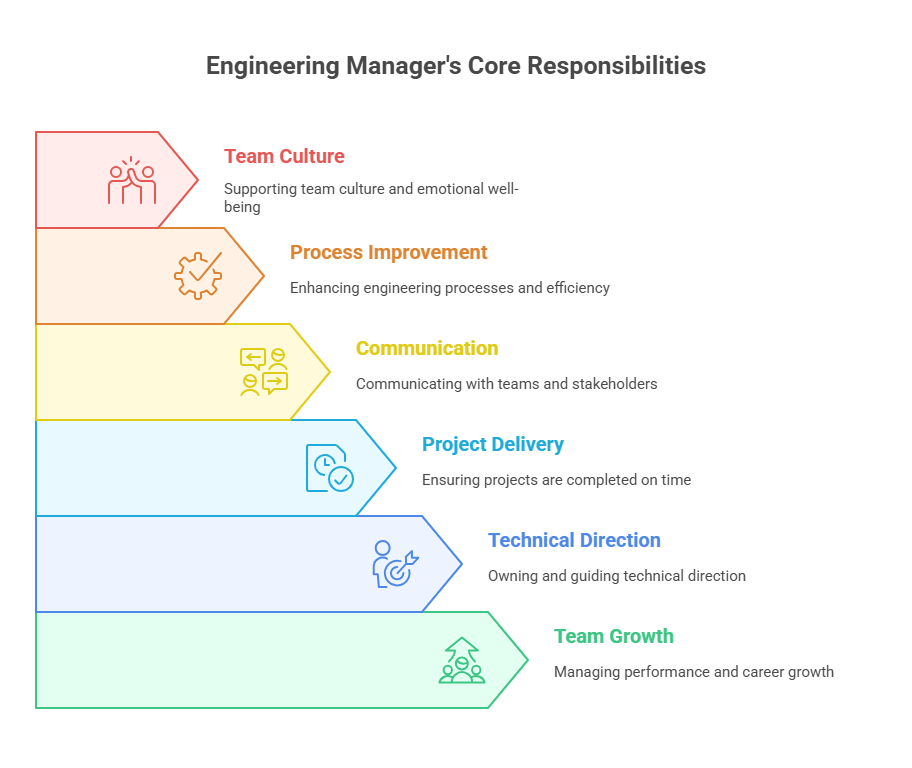Engineering managers sit at the center of tech teams, but their job isn’t just about managing people or writing code. They’re responsible for keeping projects on track, supporting their team’s growth, and making smart technical decisions that impact the entire business.
If you’ve ever wondered what an engineering manager actually does day to day, this guide breaks it down, without the fluff. From team leadership to technical oversight, we’ll walk through every key responsibility so you know what to expect from the role or how to prepare for it yourself.
Core Responsibilities That Define the Engineering Manager Role
Engineering managers do more than manage—they lead, guide, and build the systems that help teams succeed. Below are the seven core responsibilities that define their role and make the biggest impact on team performance and project success.

1. Leading and Growing the Engineering Team
One of an engineering manager’s first jobs is building a strong, balanced team. That starts with writing clear job descriptions, screening candidates, and making thoughtful hiring decisions that align with both skill needs and team dynamics.
Once a new hire joins, the manager is responsible for making onboarding smooth and structured. This includes introducing the team’s tools, workflows, and expectations—so new engineers can start contributing with confidence.
But building a team doesn’t stop after hiring. Engineering managers regularly check in with team members, understand what drives them, and offer support through coaching or learning opportunities. They help engineers build the skills they need not just to perform, but to grow, and make sure no one’s career feels stuck.
They also consider the big picture: balancing strengths across the team, identifying future leaders, and ensuring the team can scale as the company grows.
2. Managing Performance and Career Growth
Great teams don’t grow by accident. Engineering managers set clear, measurable goals and make sure everyone knows what success looks like. They provide regular, specific feedback—not just on the quality of the work, but also on how people collaborate, communicate, and contribute to the team.
They also track progress over time. If someone is excelling, they help open doors to new opportunities. If someone is struggling, they offer honest feedback and support to get them back on track.
Career growth isn’t left to chance. Managers guide people through transitions, advocate for promotions, and make sure that strong performance is seen, valued, and rewarded.
3. Owning Technical Direction
Engineering managers shape the technical direction of their teams. They review system designs, weigh trade-offs, and ensure that what’s being built today won’t break tomorrow. Their focus is long-term: scalable architecture, clean code, and decisions that align with both engineering standards and business goals.
While they might not write code every day, they stay close to the work, able to dive into details when needed, and guide the team through complex technical decisions. They help engineers balance speed with sustainability and keep projects grounded in smart, practical engineering.
4. Delivering Projects on Time
Shipping on time doesn’t happen by luck. Engineering managers work closely with product and design leads to define priorities, break down work, and plan sprints that are realistic and focused.
They keep a close eye on progress—not to micromanage, but to catch issues early and adjust plans before timelines slip. When blockers come up, they step in quickly, removing obstacles so engineers can stay focused on building.
Their job is to keep momentum steady, make sure goals stay aligned, and ensure the team delivers quality work without burning out.
5. Communicating Across Teams and Stakeholders
Engineering managers act as the link between technical teams and the rest of the business. They break down complex technical plans so non-engineers—like product owners or executives—can clearly understand what’s being built and why.
At the same time, they keep their team in sync with shifting priorities, customer needs, and company goals. They work side-by-side with product, design, QA, and operations to keep everyone aligned, avoid surprises, and ensure smooth handoffs across teams.
Clear, timely communication keeps projects moving and ensures engineering stays connected to the bigger picture.
6. Improving Engineering Processes
The best engineering teams focus on efficiency, not just effort. Managers regularly look at how work flows through the team and ask what can be simpler, faster, or more reliable.
They might refine sprint routines, replace outdated tools, or remove unnecessary handoffs—small changes that unlock better results. They also keep an eye on performance metrics, using real data to spot bottlenecks or slowdowns.
Their goal isn’t just to speed things up—it’s to help the team work smarter, with fewer distractions and more time to focus on what really matters.
7. Supporting Team Culture and Emotional Well-Being
Engineering is challenging work, and pressure builds quickly without the right support. A strong manager creates a team culture where people feel safe, respected, and valued. That means encouraging open communication, listening without judgment, and addressing concerns before they escalate.
They watch for signs of burnout, help resolve tensions, and ensure no one feels isolated. It’s not just about keeping morale up—it’s about creating an environment where people can do their best work and feel good about it.
Great teams don’t just ship code, they support each other. And that starts with the manager.
Common Challenges Engineering Managers Face
Even experienced engineering managers encounter tough situations. Here are five common challenges and how to handle them effectively.

1. Balancing People Management and Technical Work
It’s easy to get pulled too far into code or, on the flip side, stuck in back-to-back meetings.
How to Overcome:
Block focused time each week for strategic technical reviews and 1:1s. Delegate technical ownership where possible and stay involved through regular check-ins, not micromanagement.
2. Handling Underperformance
Addressing low performance can feel uncomfortable, especially on a small team.
How to Overcome:
Use clear, measurable goals. Give early feedback, not just during review cycles. Approach the issue with curiosity and support, not blame. If things don’t improve, take action respectfully and firmly.
3. Preventing Burnout and Team Fatigue
Fast-paced environments often push teams too hard for too long.
How to Overcome:
Watch for warning signs—missed deadlines, low energy, rising tension. Make workload reviews part of sprint planning. Protect team focus by saying no to unnecessary scope creep.
4. Keeping Communication Clear Across Teams
Misalignment with product, design, or leadership leads to confusion and frustration.
How to Overcome:
Be proactive. Share updates even when there’s “nothing new.” Use written docs, regular standups, and short async updates to keep everyone in sync.
5. Scaling the Team Without Losing Culture
As teams grow, it’s easy to lose the close-knit vibe and fast decision-making.
How to Overcome:
Document core values and rituals early. Build strong team leads who mirror your leadership style. Keep channels open for direct feedback—even as layers grow.
How Responsibilities Vary by Company Size and Structure
The core role of an engineering manager stays the same, but how it’s carried out depends heavily on company size. Here’s how the responsibilities shift across different environments.
Startups
In early-stage startups, engineering managers often wear multiple hats. They might write code daily, lead product discussions, manage hiring, and still be responsible for delivery.
With smaller teams, there’s less structure, so the manager sets the tone, builds the culture, and makes fast decisions. Speed matters, but so does staying close to customers and adapting quickly.
Key focus: Hands-on execution, hiring, and building team trust from scratch.
Mid-Size Companies
At this stage, teams are growing and processes are forming. Engineering managers step back from coding and focus more on people leadership, planning, and scaling systems.
They often manage multiple engineers across one or two teams. Communication, coordination, and performance reviews become a bigger part of the job. There’s a stronger need to align with product and design partners.
Key focus: Team management, delivery consistency, and supporting engineers as they grow.
Large Enterprises
In large organizations, engineering managers become more strategic. They rarely code but are deeply involved in planning, cross-team alignment, and long-term decision-making.
They may manage other managers or oversee entire functions. Navigating org changes, aligning with business goals, and handling complex dependencies take up most of their time.
Key focus: Strategy, scaling leadership, and maintaining alignment across many teams.
Conclusion
Being an engineering manager isn’t about checking boxes—it’s about impact. The real value lies in helping people grow, guiding teams through uncertainty, and making decisions that move the business forward. It’s a role built on trust, clarity, and consistency, where small actions often shape the biggest outcomes.
Whether you’re stepping into the role or working alongside someone in it, understanding these responsibilities isn’t just useful—it’s essential. It helps teams run smoother, leaders grow faster, and products reach their full potential.
And if you’re aiming to become a stronger engineering manager, start where it matters most: listen more, assume less, and always make space for the people doing the work.




